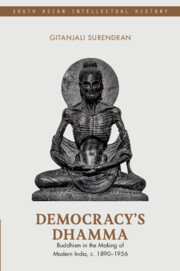Book contents
- Frontmatter
- Dedication
- Contents
- List of Figures
- Acknowledgements
- List of Abbreviations
- Introduction: Buddhism in the Making of Modern India
- 1 Anagarika Dharmapala in India
- 2 Dharmapala and Vivekananda in an Age of Universalism
- 3 Buddhism and The Bhadralok
- 4 The Buddhist Bay: Buddhist Mobility Across the Bay of Bengal
- 5 Buddhist Relics, The Mahabodhi Temple and The Discourse of a Shared Buddhism
- 6 Buddhism as a Civil Religion and Hindutva
- 7 Buddhism, Anti-Caste Radicalism and Socialism
- 8 Ambedkar, Dhamma and Democracy
- Conclusion: The Destinies of Buddhism
- Bibliography
- Index
2 - Dharmapala and Vivekananda in an Age of Universalism
Published online by Cambridge University Press: 28 November 2024
- Frontmatter
- Dedication
- Contents
- List of Figures
- Acknowledgements
- List of Abbreviations
- Introduction: Buddhism in the Making of Modern India
- 1 Anagarika Dharmapala in India
- 2 Dharmapala and Vivekananda in an Age of Universalism
- 3 Buddhism and The Bhadralok
- 4 The Buddhist Bay: Buddhist Mobility Across the Bay of Bengal
- 5 Buddhist Relics, The Mahabodhi Temple and The Discourse of a Shared Buddhism
- 6 Buddhism as a Civil Religion and Hindutva
- 7 Buddhism, Anti-Caste Radicalism and Socialism
- 8 Ambedkar, Dhamma and Democracy
- Conclusion: The Destinies of Buddhism
- Bibliography
- Index
Summary
THE TIME OF DHARMAPALA AND VIVEKANANDA
Few people living at that time would have had an inkling as to the importance of Chicago's 1893 World Parliament of Religions in the history of modern South Asia. Every school student in India will have read in their history textbooks about the big event in Chicago more than a century ago that gave to Indian history the figure of Swami Vivekananda, considered by many to be the founder of modern Hinduism. And yet, neither was the parliament a very unique event—there had been many efforts at inter-faith dialogue—nor was the Columbia world exposition, a gigantic exhibition of colonial and industrial wares organized to commemorate the ‘discovery’ of the Americas by Christopher Columbus 400 years earlier, the first of its kind. We can only guess that there was something fortuitous about the particular historical moment that allowed a struggling monk to gain fame and reputation that even he never expected, which in turn became the foundation for his subsequent renown and after-life in India.
By the 1870s and 1880s, the emerging professional middle class, or the bhadralok, in Bengal, the oldest British province in the Indian colony, found themselves caught between the ‘myths of improvement’ of the Bengal Renaissance and ‘nationalist deliverance’. The resulting ideological ferment led many members of the bhadralok to engage with, and fashion, new forms of public discourse, social respectability, aesthetics and morality, attendant gender and community norms, and, eventually, political mobilization. This powerful Indian, western-educated elite debated not only some of the most fashionable ideas and theories of the day like Darwinism, comparative religions and nationalism but also generated new ideas about Indian history, civilizations and social reform in a colonial milieu. In fact, as Tanika Sarkar argues, religion, family and community norms became sites of self-fashioning for the emerging intelligentsia. The bhadralok class comprised government servants, professionals, scholars, men of commerce and men of the arts, who constituted a self-appointed ‘native’ intelligentsia.
But the 1890s were an especially formative decade. The age of consent controversy had whipped up a public frenzy in Calcutta, which served as a foundation for future nationalist activity. Elsewhere, in north India, it was a decade of violent communal rioting between Hindus and Muslims as the cow protection movement gained ground.
- Type
- Chapter
- Information
- Democracy's DhammaBuddhism in the Making of Modern India, c. 1890–1956, pp. 51 - 86Publisher: Cambridge University PressPrint publication year: 2025

